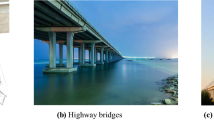Abstract
A major bottleneck preventing widespread use of Structural Health Monitoring (SHM) systems for bridges is the difficulty in making sense of the collected data. Characterising environmental effects in measured bridge behaviour, and in particular the influence of temperature variations, remains a significant challenge. This paper proposes a novel data-driven approach referred to as Temperature-Based Measurement Interpretation (TB-MI) approach to solve this challenge. The approach is composed of two key steps—(1) characterisation of thermal effects in bridges using a methodology referred to as Regression-Based Thermal Response Prediction (RBTRP) methodology, and (2) detection of anomaly events by analysing differences between measured and predicted structural behaviour. Measurements from a laboratory truss structure that is setup to simulate a range of structural scenarios are employed to evaluate the performance of the TB-MI approach. The study examines how the predictive capability of the RBTRP methodology is influenced by dimensionality reduction and measurement down-sampling, which are common pre-processing techniques used to deal with high spatial and temporal density in measurements. It also proposes a novel anomaly detection technique referred to as signal subtraction method that detects anomaly events from time-series of prediction errors, which are computed as the difference between in situ measurements and predictions obtained using the RBTRP methodology. Results demonstrate that the TB-MI approach has potential for integration within data interpretation frameworks of SHM systems of full-scale bridges.

















Similar content being viewed by others
References
Doebling SW, Farrar CR, Prime MB (1998) A summary review of vibration-based damage identification methods. Shock Vib Dig 30(2):91–105
Hejll A (2007) Civil structural health monitoring: stratigies, Methods and Applications. Doctoral Thesis, Luleå University of Technology
Sazonov E, Li H, Curry D, Pillay P (2009) Self-powered sensors for monitoring of highway bridges. Sens J IEEE 9(11):1422–1429
Federal Highway Administration (FHWA) (2014) Tables of frequently requested NBI information [online]. Available: http://www.fhwa.dot.gov/bridge/deficient.cfm. Accessed 4 May 2015
Catbas FN, Kijewski-Correa T, Aktan AE (2011) Structural Identification (St-Id) of constructed facilities. American Society of Civil Engineers (ASCE) Structural Engineering Institute (SEI)
Brownjohn JMW, De Stefano A, Xu Y-L, Wenzel H, Aktan AE (2011) Vibration-based monitoring of civil infrastructure: challenges and successes. J Civ Struct Heal Monit 1:79–95
Catbas FN, Susoy M, Frangopol DM (2008) Structural health monitoring and reliability estimation: long span truss bridge application with environmental monitoring data. Eng Struct 30(9):2347–2359
Goulet JA, Kripakaran P, Smith IFC (2010) Multimodel Structural Performance Monitoring. J Struct Eng 136(10):1309–1318
Wood SL (1992) Evaluation of the long-term properties of concrete. ACI Mater J 88(6):630–643
Xia Y, Chen B, Weng S, Ni YQ, Xu YL (2012) Temperature effect on vibration properties of civil structures: a literature review and case studies. J Civ Structrual Heal Monit 2:29–46
Sohn H, Worden K, Farrar C (2002) Statistical damage classification under changing environmental and operational conditions. J Intell Mater Syst Struct 13(9):561–574
Posenato D, Lanata F, Inaudi D, Smith IFC (2008) Model-free data interpretation for continuous monitoring of complex structures. Adv Eng Informatics 22(1):135–144
Posenato D, Kripakaran P, Inaudi D, Smith IFC (2010) Methodologies for model-free data interpretation of civil engineering structures. Comput Struct 88:467–482
Laory I, Trinh TN, Smith IFC (2011) Evaluating two model-free data interpretation methods for measurements that are influenced by temperature. Adv Eng Informatics 25(3):495–506
Laory I, Trinh TN, Posenato D, Smith IFC (2013) Combined model-free data-interpretation methodologies for damage detection during continuous monitoring of structures. J Comput Civ Eng 27(6):657–666
Peeters B, De Roeck G (2001) One-year monitoring of the Z 24-Bridge: environmental effects versus damage events. Earthq Eng Struct Dyn 30(2):149–171
Worden K, Cross EJ, Brownjohn JMW (2013) Switching response surface models for structural health monitoring of bridges. In: Surrogate-Based Modeling and Optimization, Springer, pp 337–358
Figueiredo E, Cross E (2013) Linear approaches to modeling nonlinearities in long-term monitoring of bridges. J Civ Struct Heal Monit 3(3):187–194
del Grosso A, Lanata F (2013) A long-term static monitoring experiment on RC beams: damage identification under environmental effect. Struct Infrastruct Eng 10(7):911–920
Cross EJ, Worden K, Chen Q (2011) Cointegration: a novel approach for the removal of environmental trends in structural health monitoring data. Proc R Soc A Math Phys Eng Sci 467(2133):2712–2732
Kulprapha N, Warnitchai P (2012) Structural health monitoring of continuous prestressed concrete bridges using ambient thermal responses. Eng Struct 40:20–38
Kromanis R, Kripakaran P (2014) Predicting thermal response of bridges using regression models derived from measurement histories. Comput Struct 136:64–77
Kromanis R, Kripakaran P (2013) Support vector regression for anomaly detection from measurement histories. Adv Eng Informatics 27(4):486–495
Branco FA, Mendes PA (1993) Thermal actions for concrete bridge design. J Struct Eng 119(8):2313–2331
Emanuel JH, Taylor CM (1985) Length-thermal stress relations for composite bridges. J Struct Eng 111(4):788–804
Potgieter IC, Gamble WL (1989) Nonlinear temperature distributions in bridges at different locations in the united states. PCI J 34(4):80–103
Ganguli R (2002) Noise and outlier removal from jet engine health signals using weighted FIR median hybrid filters. Mech Syst Signal Process 16(6):967–978
Gul M, Catbas FN (2011) Structural health monitoring and damage assessment using a novel time series analysis methodology with sensor clustering. J Sound Vib 330(6):1196–1210
Worden K, Cross E, Barton E (2012) Damage detection on the NPL footbridge under changing environmental conditions,” In: 6th European Workshop on Structural Health Monitoring pp 1–8
Kromanis R (2015) “Structural performance evaluation of bridges: characterizing and integrating thermal response. University of Exeter
Catbas FN, Gul M, Burkett JL (2008) Conceptual damage-sensitive features for structural health monitoring: laboratory and field demonstrations. Mech Syst Signal Process 22(7):1650–1669
Acknowledgments
The authors would like to express their gratitude to Bill Harvey Associates and Pembrokshire County Council for providing access to the measurements of the Cleddau Bridge, and to Elena Barton (National Physical Laboratory) for providing the data from the National Physical Laboratory Footbridge project.
Author information
Authors and Affiliations
Corresponding author
Rights and permissions
About this article
Cite this article
Kromanis, R., Kripakaran, P. SHM of bridges: characterising thermal response and detecting anomaly events using a temperature-based measurement interpretation approach. J Civil Struct Health Monit 6, 237–254 (2016). https://doi.org/10.1007/s13349-016-0161-z
Received:
Accepted:
Published:
Issue Date:
DOI: https://doi.org/10.1007/s13349-016-0161-z




